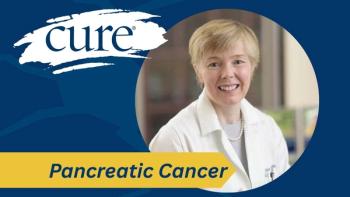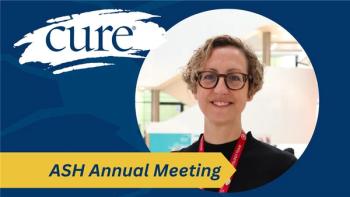
Moving the Needle With Disparities in Multiple Myeloma
Increased awareness and support may be one of the many ways to help decrease the impact of disparities in multiple myeloma.
As multiple myeloma disproportionately affects minority patients compared with the rest of the population, increasing awareness to the disease and available resources may be one of many ways to make an impact on the disparity, experts said.
At a panel on diversity, equity and inclusion at the CURE Educated Patient Multiple Myeloma Summit, Dr. Brandon J. Blue, of Moffitt Cancer Center, and Byron Daily, of The Leukemia & Lymphoma Society, discussed the disparities surrounding multiple myeloma and how the entire health care spectrum can help move the needle in this area.
What are some of the biggest challenges faced by minority communities when it comes to, specifically, a multiple myeloma diagnosis and treatment?
Daily: Well, there's multiple challenges within the community. First of all, myeloma happens to be one of the blood cancers that has the distinct unfortunate disparity, where Blacks were diagnosed at a two-to-one rate versus the rest of the population. I happen to be a patient, so I have a personal stake in helping move that needle.
But it can be financial, access to insurance, whether it's underinsured or lack of insurance. Stress is definitely a factor in contributing towards the disease. So there's a lot of challenges that have to be overcome even prior to being diagnosed.
Blue: I think you brought up some great points, Byron. I think that we got to let people know that they even have the disease. And so just let people know what's wrong with their body. And so I think that that's really a really good point that you brought up. So myeloma is something that a lot of people haven’t even heard of, and unfortunately, is disproportionately affecting people of color, and it's disproportionately killing people of color. Because not only are we getting the rates higher, like you mentioned, but unfortunately, we have worse outcomes. And so we got to fix that.
Dr. Blue, what challenges are you seeing firsthand in the clinic as it pertains to DEI in myeloma, whether it be access to testing, for example?
Blue: I think one of the biggest problems that is going to worsen if we don't do something about it, is making sure that these new therapies and the new treatments that we have for multiple myeloma get to the people who need them the most. OK, so you'll hear a lot of presentations today about the new updates in multiple myeloma, and all these new fantastic drugs and CAR-T [cell therapies] and bispecifics, all these like really fancy things. But if they're not getting to the people who are already in last place, then what happens is that the gap that's currently there is going to keep getting wider and wider and wider. I keep myself up at night sometimes, because I'm worried about that, to be honest with you. And I'm happy for the myeloma community, because I'm always happy to make sure that our patients have options. Like, I think it's wonderful that we have these options. But if they're not reaching the people, I think we're doing a big disservice.
Daily: It starts with education and awareness, which is a huge challenge in itself. Because, me, for example, I didn't know anything about myeloma until I got diagnosed, and then having to find the information that's reliable, information about the disease, rather than Googling it like most people do, that was a challenge. But fortunately, I had access to a system that introduced me to The Leukemia & Lymphoma Society, where they're experts in blood cancer.
Dr. Blue, are there any gaps in our current research on multiple myeloma that disproportionately affect certain populations? And if so, how can we address these gaps?
Blue: Some of the biggest things that we're trying to figure out now that I think we still haven't quite figured out, I think we've done a good job, but what we're still trying to hone onto is, is this a nature versus nurture issue? I think that's one of the things that people are still a little bit confused about. Because if you notice that the incidence of multiple myeloma is higher for people of color, meaning people who have African ancestry — so whether that be African Americans or people who are still in the continent of Africa, or people who are from a Hispanic background, have higher rates of this disease. So that makes you think that there's something biologically that's happening there because that is passed down from an ancestry standpoint.
However, the people who are dying the most from this disease are still those people. But if you look at the biology of the cancer, meaning the rate of the cancer growth, the adverse effects, what we call high-risk multiple myeloma, it's not the people of African ancestry who have the more high-risk disease. So it doesn't add up. If you're telling me that the more aggressive cancer is not from the people who are dying the most from it, then is it just a lack of exposure? is this more of a product of their environment then if it's not from a biology standpoint? So I think that's one of the biggest, if we could kind of answer that question, I think it would help us move things forward. Because I think that it's hard for us to know how to fix something if we don't know what the problem is. Like, I don't know if you've ever been driving, and you hear a noise in your car, you think it’s one thing, but you show up to the mechanic and mechanic is like, “No, it’s something else,” typically much more expensive, and so I think that you can't fix until you know what the problem is. Just because you hear the noise, you know something's wrong. And I think, at this point, we know that there's an issue, but how do we go about fixing it? We have to identify the specific issue. And I think that's really one of the big issues, is it nature versus nurture? I think we're starting to really try to figure out at this point, that it really might be a nurture component, like it might not be the biology, it might be something that we're doing, and we got to take ownership of this as a healthcare system. It could be us, that's the problem. And we need to change some stuff within the stuff that we're doing, that makes sure that these people who should be alive are still alive to benefit from it.
Daily: I want to piggyback on what Dr. Blue was saying regarding the biological factor. The NIH did a study among veterans a few years ago, and it was determined that people of color who were treated using the same treatment actually had a better outcome for the disease. So that suggests that there's other factors that are involved, not just biological, that impact our mortality rates.
Blue: We call those things the social determinants of health. So, if you have two people who have the same exact diagnosis, you say, “Well, what are the other things that play a factor into their health care? Can they read?” If I give you a prescription, if you can't read the bottle, that's a problem. “Do you have access to healthy foods? How far is the closest grocery store to where you live? How did you show up to the clinic today? Did you take a bus? Did you walk? Did you drive a $100,000 car? Or did you come by yourself? Do you have a support system? Do you have a significant other? Do you have a brother, a sister, a cousin? Do you have kids, you know, somebody else who could be with you?” Because when we tell very complicated cancer things, too — nobody does well when they’re by themselves. And so I tell people that even if you don't have someone in your immediate area, you need to have somebody who can at least phone call you every day or every other day, and just make sure, hey, did you remember that lenalidomide medicine that the doctor told you that we talked about? Are you taking that? It’s always good.
I have to piggyback and talk about myself a little bit. At one point, I caught myself trying to go to the gym. I told myself, I was going to go to the gym, and I was going to be the first one there, the last one to leave. And then I did it one day, then it turned in a week went by, two weeks went by, it wasn't until I joined a group where it was people being like, “Hey, Brandon, where are you? You're not at the gym today.” And then I'm like, “I have got to go.” And that’s when I really saw improvement. So the same thing is happening. That's why I'm such a proponent for things like support groups, and things like that, because those are things that, again, have nothing to do with the biology of your disease. But these are things that are super important and can play a super big impact on your outcome.
Byron, can you discuss your involvement with The Leukemia & Lymphoma Society? And can you offer some information on the work you've been doing with the organization and its role in addressing disparities in myeloma care?
Daily: Sure. So my introduction to blood cancer was as a patient. Once I had recovered, went through the standard procedure, which was discussed earlier, I had a bone marrow transplant, autologous, and recovered quite well. I volunteered with The Leukemia & Lymphoma Society afterwards. It was right before COVID-19 had begun. And so I was able to give back to the community. I was very interested in doing that because after learning that disparity related to the disease, I wanted to make sure that I could pass that information on.
And so I started off as a volunteer. Several months later, an opening became available at the organization. And I'm currently the National Community Outreach Manager for what we call the Myeloma Link Initiative, which takes place in 15 cities across the country, strategically urban communities where there's a high concentration of members of the Black population who are most vulnerable. And so we go out, we partner with the community. They say meet people where they are. So we partner with stakeholders, influencers, churches are always a good place to establish those partnerships. And we do our part to make sure that people are aware that the resources that we have available at The Leukemia & Lymphoma Society are free, and it’s something they can take advantage of.
Blue: I also want to tell people as well. Now, myeloma may not be in the name, but LLS does a fantastic job of supporting multiple myeloma. So I would recommend everyone who has multiple myeloma to go to lls.org. It's a very simple website, and it's very easy to navigate. I'll tell you something important, too, that LLS does. I call it LLS, but it's The Leukemia & Lymphoma Society. But again, they represent multiple myeloma. They have people, like an actual person you can talk to, that can walk you through your disease, can actually help you navigate some of these medicines. And sometimes they even have money to help you pay for some of the travel and healthcare-related costs. So I'll tell you, it's worth its weight in gold.
Now, I'm a little bit old school. So for people who are listening, what that means is, that I'm still the person who goes inside the bank, I'm still the person who goes inside the post office. And for a lot of our patients, they're the same way. And so I appreciate LLS because they have literally an actual person you can talk to, and it's nothing like talking to a person, the fancy technology stuff is it's cool and it's nice, but it's nothing like talking to a human being. So I highly recommend that, lls.org.
Disparities need to be addressed on all sides of the spectrum. How can we all work together to address these challenges?
Daily: Well, I think it takes a concerted effort to address the issue. I think that starting with the most vulnerable population, obviously, is going to reveal some nuances of how we can address treatment, and also help the community understand their part in being their own self advocate. And I think that's also something that needs to be — I mean, that’s across the board for every patient, being your best self advocate, asking questions, understanding what clinical trials are.
That's another issue where we have. We have a need for higher representation among people of color, participating in clinical trials. There's a lot of reasons why that that exists. But everyone, from nurses, primary care physicians, family members, are all responsible for helping to promote that information. And that's where we find the best partnerships.
Blue: I would just say two things. I would say from a patient standpoint, my No. 1 thing is to have somebody with you. Do not show up to your cancer doctor visits alone, especially the first visit. It’s so much information. You need somebody. And again, if they can't come in person, just try to make sure you can have somebody on the phone, on FaceTime, on Skype, on Zoom, on Teams, on one of these many platforms. Just have somebody there with you.
The second thing I would say from a healthcare system is that we, as the healthcare, we need to recognize that not everybody looks at the doctor as a favorable thing. And we need to be vulnerable and meet people where they are, like Byron said. And so we need to know that it's been some things that makes this person look at somebody with a white coat like what I have on and just not make it a warm and fuzzy feeling. And so we have to own that. And we have to know that we have the responsibility of breaking down those barriers, making sure that we ensure the trust of our patients, and make sure that we don't just do what we call a cookie-cutter approach. Look at each person, not just as a patient, but as an individual, as somebody who we're trying to help in their cancer journey.
As we're nearing the end of this panel, any final thoughts on this topic?
Daily: I want to, first of all, just thank Dr. Blue for the work he's done. It's been exemplary, I mean, you're present. You don't mind talking about, you know, the hard topics, things that are very important to helping us move the needle in terms of health disparities. Thank you for what you do.
Blue: I appreciate that. My last comment for folks just listening is that just try to do the best that you can. Like there's going to be cultures and types of people that may not come from places that you come from, or have a different view of the world than what you come from, and just recognize that that's OK. And just know that not all Black people are the same. Not all Hispanic people are the same. Not all people of European ancestry are the same. And so what we just have to do again, is to really try our best to do an individualized approach, and not try to just treat people from what we come from our prejudge our biases that we come into the conversation with. So that would be my one thing. But like I said, just each person try to move the needle. And if we do that, that needle will keep getting closer and closer to the goal.
This transcript has been edited for clarity and conciseness.
For more news on cancer updates, research and education, don’t forget to





